Eastern Washington receives only 7-12 inches of annual rainfall, yet you can create stunning landscapes that thrive in this challenging environment. You’ll discover that native plants aren’t just survivors—they’re remarkably beautiful performers that’ll transform your garden while slashing water bills. The secret lies in understanding which species actually prefer these harsh conditions, and there’s one particular group of wildflowers that’ll surprise you with their resilience and striking displays.
Contents
- 1 Eastern Washington’s Arid Climate Challenges
- 2 Drought-Tolerant Wildflowers for Gardens
- 3 Eastern Washington Native Trees
- 4 Hardy Native Shrubs for Landscaping
- 5 Selecting the Right Native Plants for Your Garden
- 6 Frequently Asked Questions
- 6.1 When Is the Best Time to Plant Native Species in Eastern Washington?
- 6.2 How Often Should I Water Newly Planted Native Plants During Establishment?
- 6.3 Do Native Plants in Eastern Washington Require Special Fertilizers or Soil Amendments?
- 6.4 Which Native Plants Attract Local Wildlife Like Birds and Pollinators?
- 6.5 Where Can I Purchase Native Plant Seeds and Seedlings in Eastern Washington?
Eastern Washington’s Arid Climate Challenges
While Western Washington gets drenched with rain, Eastern Washington sits in what’s called a rain shadow, creating a completely different world just a few hundred miles away. You’re dealing with an arid climate that receives just 7-9 inches of rainfall annually in central areas.
The Cascade Mountains block moisture from reaching your region, leaving you with desert-like conditions. You’ll face scorching summers with low humidity and bone-dry winters. This creates serious irrigation challenges for any gardening efforts.
Your plants must survive 300 days of intense sunshine with minimal natural water sources. The region’s rich volcanic soil provides excellent growing conditions for adapted species despite the challenging climate.
Drought-Tolerant Wildflowers for Gardens
Eastern Washington’s arid climate supports remarkable drought-tolerant native wildflowers that provide continuous blooms, attract pollinators, and require minimal water once established in home gardens. Many species like Camas and Nodding Onion thrive in full sun conditions while offering extended flowering periods that sustain garden color throughout the growing season.
Blanketflower (Gaillardia Aristata)
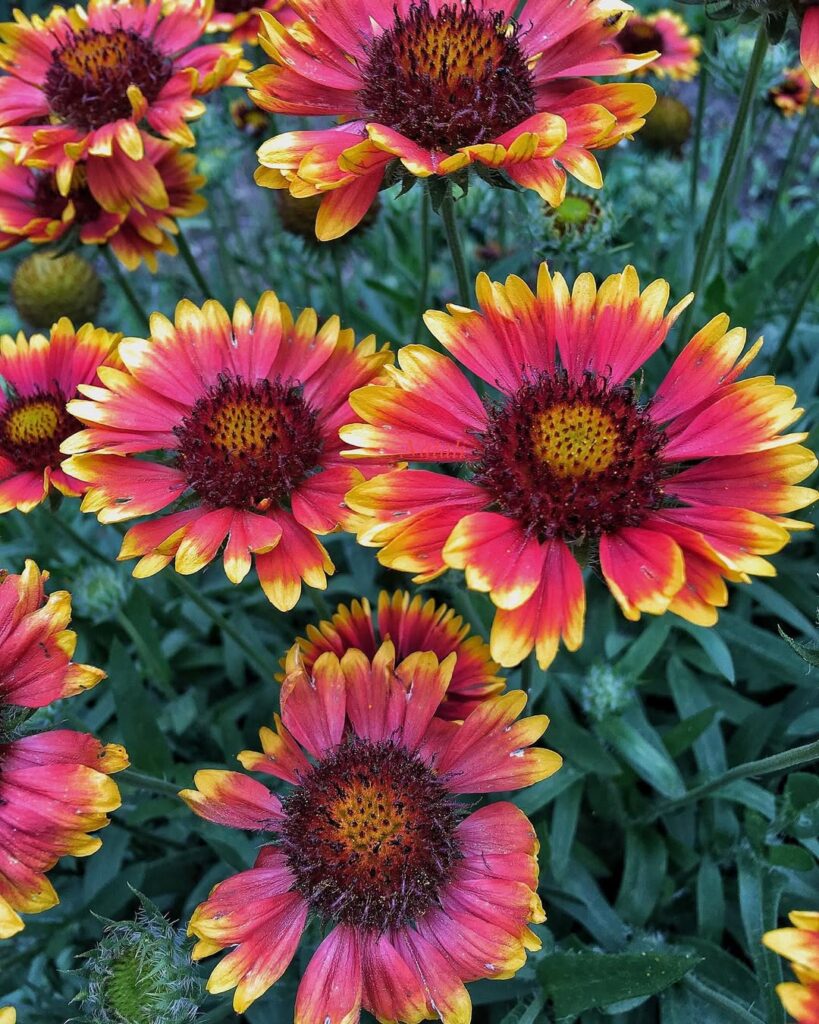
Blanketflower is a vibrant perennial wildflower native to eastern Washington’s dry steppe habitats and prairie meadows. This drought-tolerant forb produces striking yellow, red, or bicolor daisy-like flowers from late spring through late summer, reaching up to 2 feet in height with lance-shaped basal foliage. As a keystone species in bunchgrass and sagebrush communities, it serves as an important nectar source for native bees, butterflies, and specialist moths.
Highly adaptable and low-maintenance, blanketflower thrives in well-drained soils and can remain dormant during extremely dry years, rebounding with prolific blooms when moisture returns. It quickly colonizes disturbed sites, providing erosion control while adding season-long color to gardens, rock gardens, and restoration landscapes. This resilient wildflower handles urban heat exceptionally well, making it ideal for drought-tolerant pollinator gardens and native plant landscapes. The plant produces distinctive bristly seeds upon ripening, which aid in natural dispersal and self-seeding.
- Hardiness: USDA zones 3-10, elevations 1,300-9,000 feet
- Light: Full sun
- Water: Low to moderate; 5-35 inches annual precipitation, highly drought tolerant
- Soil: Well-drained, dry to mesic soils; tolerates slightly acidic to mildly alkaline pH
- Fertilizer: None required; thrives in low-nutrient conditions
- Pest/Disease Resistance: Excellent; very few pest or disease issues
- Growth Rate: Moderate; establishes quickly and may self-sow
Desert Lupine (Lupinus Lepidus)

Desert Lupine (Lupinus lepidus) is a compact perennial wildflower growing 4-8 inches tall with silky-haired, palmately divided leaves and dense, cone-shaped spikes of violet or white flowers. This drought-tolerant native thrives in the challenging conditions of Eastern Washington’s shrub-steppe, from lowland prairies to alpine ridges. Blooming from June to August, it attracts diverse pollinators including bumblebees, butterflies, and beetles, making it valuable for supporting local ecosystems while requiring minimal water once established. The plant features distinctive silvery hairs on the underside of its leaflets, adding to its ornamental appeal in native plant gardens.
- Hardiness: Adapted to Eastern Washington climate zones, tolerates extreme temperature variations from alpine to lowland conditions
- Light: Full sun to partial sun, thrives in open areas and exposed locations
- Water: Low water requirements once established, highly drought-tolerant, no supplemental watering needed
- Soil: Well-draining, poor to moderate fertility soils, tolerates gravel, sandy, and rocky substrates with low nutrient content
- Fertilizer: None required, adapted to nutrient-poor conditions
- Pest/Disease Resistance: Generally resistant due to native adaptation, no major pest or disease concerns
- Growth Rate: Moderate, perennial growth habit with mat-forming spread
Yarrow (Achillea Millefolium)
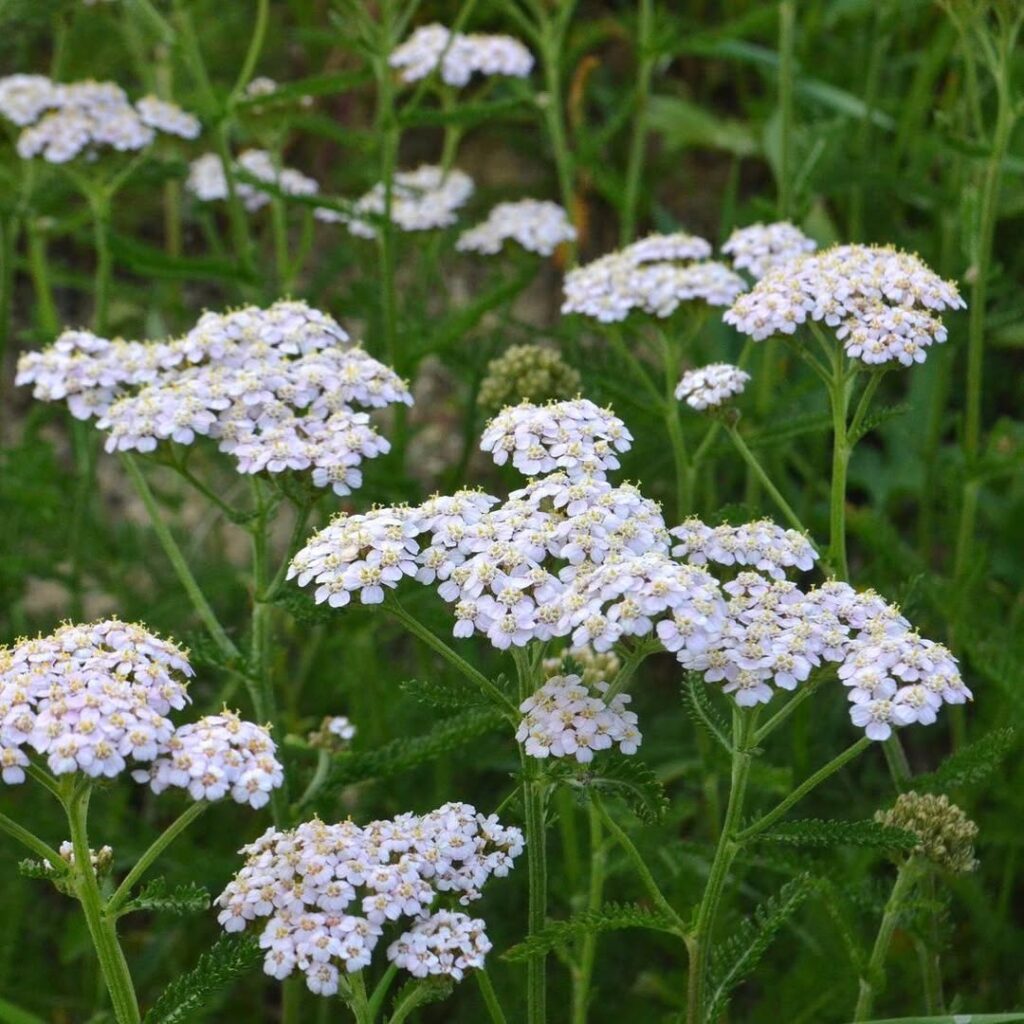
Yarrow is a hardy herbaceous perennial native to the Northern Hemisphere that produces clusters of small, creamy-white flowers from May through September. This drought-tolerant wildflower features distinctive fernlike foliage with finely dissected leaves and grows 10-40 inches tall from spreading rhizomes. The entire plant is covered in soft, woolly hairs and releases a pleasant chamomile-like fragrance when crushed.
Yarrow serves as an excellent nectar source for butterflies and other pollinators while requiring minimal maintenance once established. Its exceptional adaptability to various growing conditions and extended bloom period make it ideal for Eastern Washington gardens, where it can naturalize in disturbed soils and provide consistent color throughout the summer months. The plant can grow at elevations from sea level to 11,500 feet, demonstrating its remarkable tolerance to diverse environmental conditions.
- Hardiness: USDA zones 3-9
- Light: Full sun to partial shade
- Water: Low to medium; drought tolerant once established
- Soil: Well-drained, medium to dry; tolerates poor and calcareous soils
- Fertilizer: Low requirements; thrives in poor soils
- Pest/Disease Resistance: Generally resistant to most pests and diseases
- Growth Rate: Moderate to fast; spreads via rhizomes
Indian Paintbrush (Castilleja Hispida)
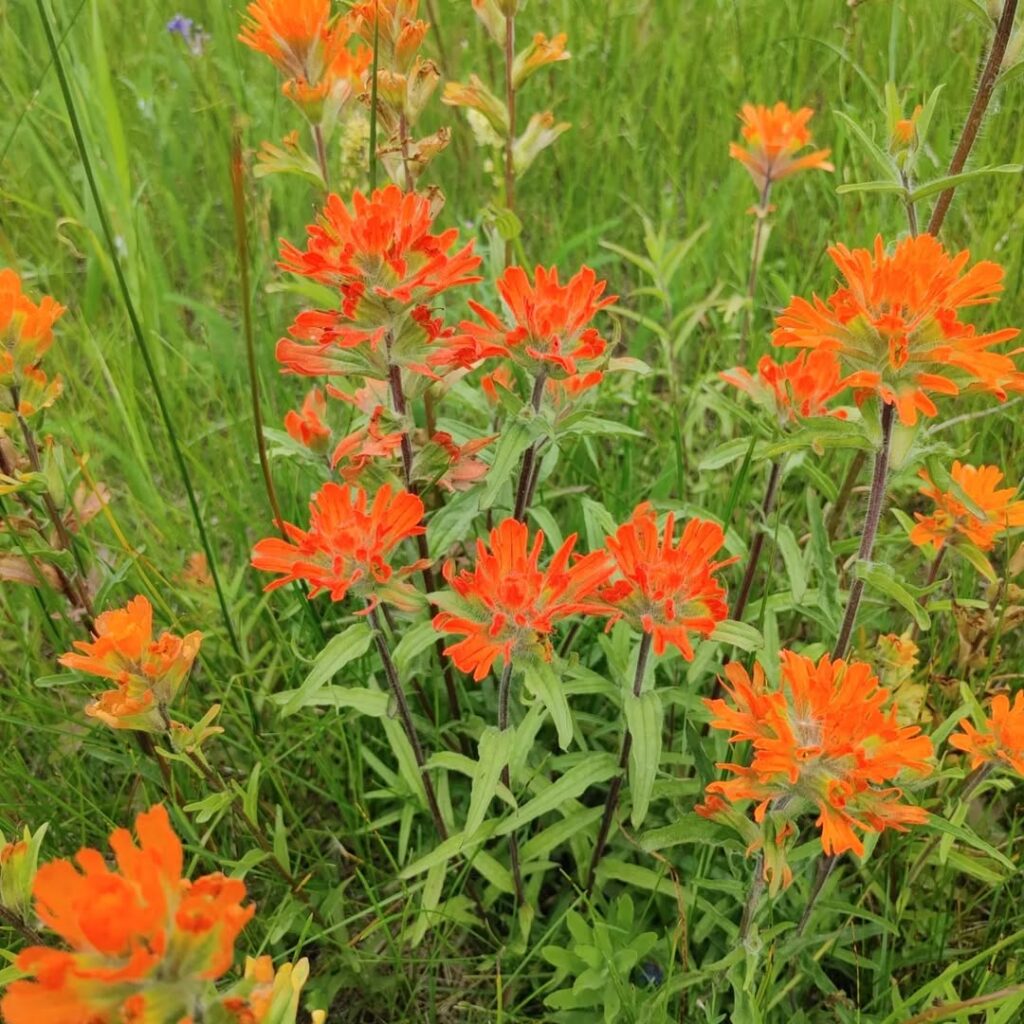
Indian Paintbrush (Castilleja hispida) is a striking native wildflower renowned for its brilliant scarlet, orange, or yellow bracts that create spectacular spring and early summer displays. This hemiparasitic perennial reaches 10-19 inches tall and thrives in eastern Washington’s dry conditions by partially parasitizing neighboring grasses for nutrients while maintaining its own photosynthetic capacity.
Perfect for drought-tolerant wildflower gardens, Indian Paintbrush requires minimal water once established and attracts hummingbirds and native pollinators with its vibrant blooms. Its bristly, light-green foliage and fast growth rate make it ideal for naturalized meadow plantings and restoration projects, though its short-lived nature may require periodic reseeding. While primarily found in California’s Klamath Mountain Range, this adaptable species can thrive in similar mountainous terrain throughout the western United States.
- Hardiness: Zones 4-8, elevation tolerant 700-5,600 feet
- Light: Full sun to partial shade (prefers partial shade in lower elevations)
- Water: Low to moderate; drought-tolerant once established
- Soil: Well-drained, dry soils; adaptable to various soil types
- Fertilizer: None required; benefits from association with native grasses
- Pest/Disease Resistance: Generally resistant; minimal pest issues
- Growth Rate: Fast-growing but short-lived perennial
Penstemon (Beardtongue) Species
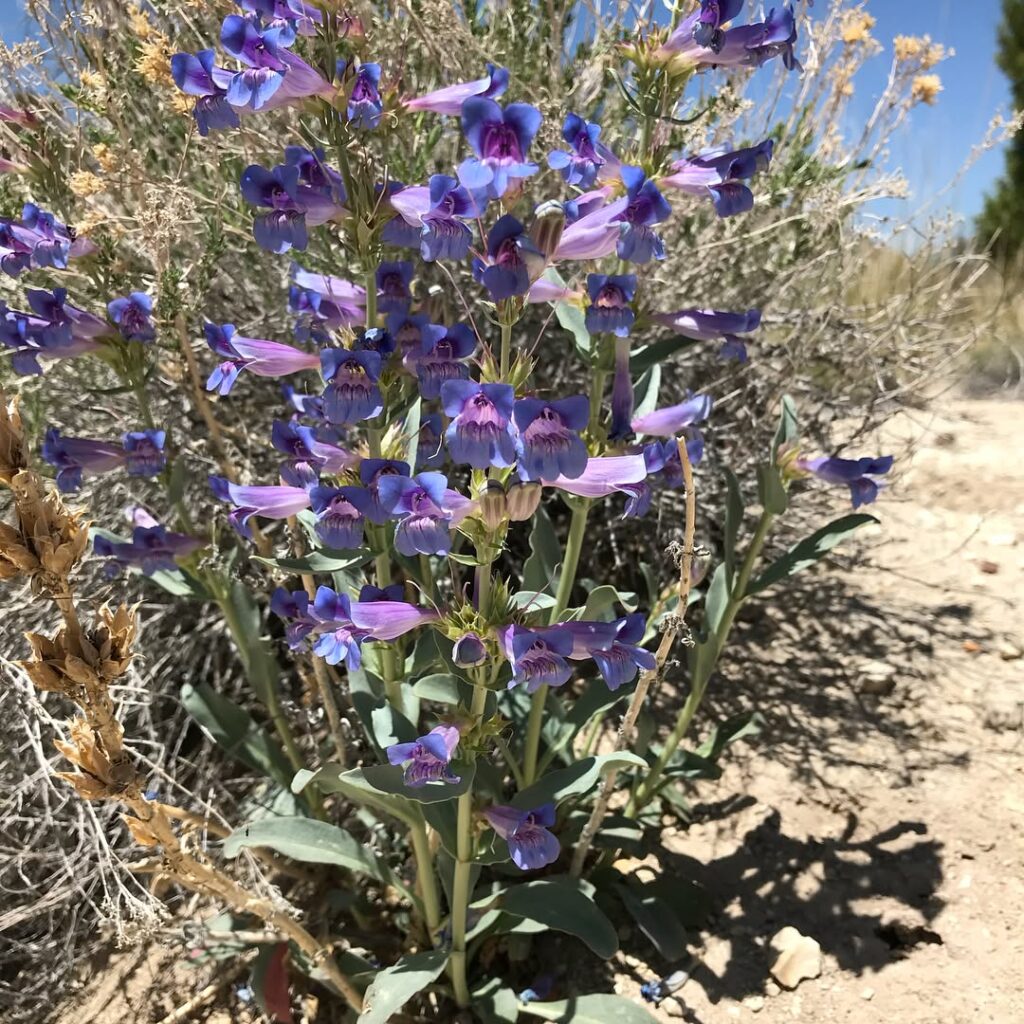
Penstemon species, commonly known as beardtongue, are exceptional drought-tolerant wildflowers perfectly suited for Eastern Washington gardens. These hardy perennials produce striking tubular flowers from April through July, with colors ranging across the spectrum. Native species like royal beardtongue (P. speciosus) and Chelan penstemon (P. pruinosus) are naturally adapted to the region’s semi-arid conditions and diverse habitats.
These versatile plants thrive in rock gardens, native plant displays, and xeriscaped landscapes. Plant multiple specimens together for maximum visual impact, as they readily establish in challenging conditions including rocky outcroppings and sandy soils. Penstemons provide vital nectar for native pollinators while requiring minimal maintenance once established. Their tubular flowers are particularly attractive to butterflies and hummingbirds throughout the growing season.
- Hardiness: USDA zones 4-8, well-adapted to Eastern Washington’s temperature extremes and semi-arid climate
- Light: Full sun to partial shade, with most species preferring bright, open conditions
- Water: Low water requirements once established; drought-tolerant with excellent tolerance for dry periods
- Soil: Well-draining soils including rocky, sandy, or clay conditions; thrives in poor to moderate fertility soils
- Fertilizer: Little to no fertilization needed; excess nutrients may reduce flowering and plant vigor
- Pest/Disease Resistance: Generally excellent resistance to pests and diseases when grown in appropriate conditions
- Growth Rate: Moderate; establishes readily and may self-seed to form larger colonies over time
Eastern Washington Native Trees
Eastern Washington’s native trees are dominated by drought-tolerant conifers including ponderosa pine, lodgepole pine, western larch, interior Douglas fir, and grand fir, each with distinct adaptations. Additional native species like quaking aspen and black cottonwood provide diversity in riparian areas and moist microsites throughout the region.
Ponderosa Pine (Pinus Ponderosa)
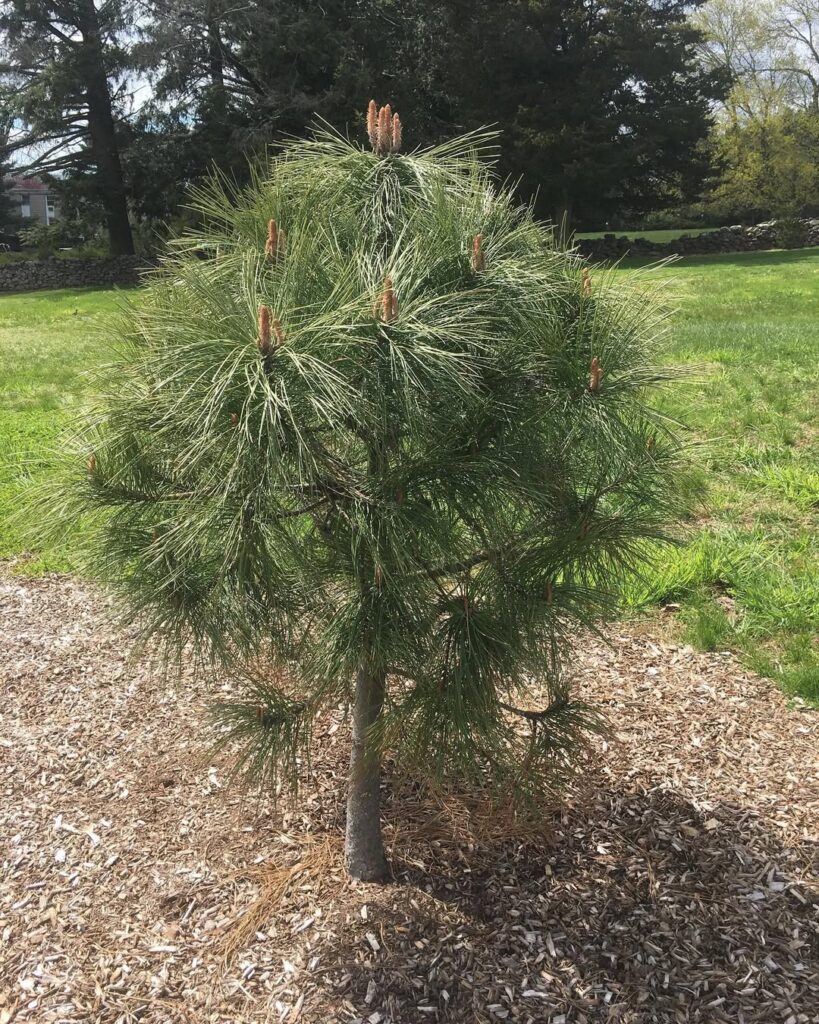
The ponderosa pine, also known as bull pine or western yellow-pine, is Eastern Washington’s most iconic native conifer and serves as Spokane’s official city tree. This majestic pine features distinctive dark green needles in clusters of three and develops striking cinnamon-yellow bark plates as it matures. As the most widely distributed pine in North America, it represents the shift from sagebrush steppe to mountain forests.
Capable of reaching 90-150 feet in height, ponderosa pines are remarkably long-lived trees that can survive approximately 600 years. Their heavy, resinous wood provides excellent decay resistance, making them valuable timber trees. The species produces egg-shaped brown cones with seeds that serve as important wildlife food sources.
The ponderosa pine was first documented in modern science in 1826 by David Douglas in eastern Washington. These hardy conifers exhibit a natural fire cycle of 5 to 10 years, with low-intensity fires actually aiding their longevity through their thick protective bark.
- Hardiness: Zones 3-7, extremely cold tolerant
- Light: Full sun exposure required
- Water: Drought tolerant once established, moderate water needs
- Soil: Well-draining soils, adaptable to various soil types
- Fertilizer: Generally not required, adapted to nutrient-poor soils
- Pest/Disease Resistance: High resistance when healthy due to abundant resins; fire-resistant when mature
- Growth Rate: Rapid growth rate in ideal conditions
Quaking Aspen (Populus Tremuloides)
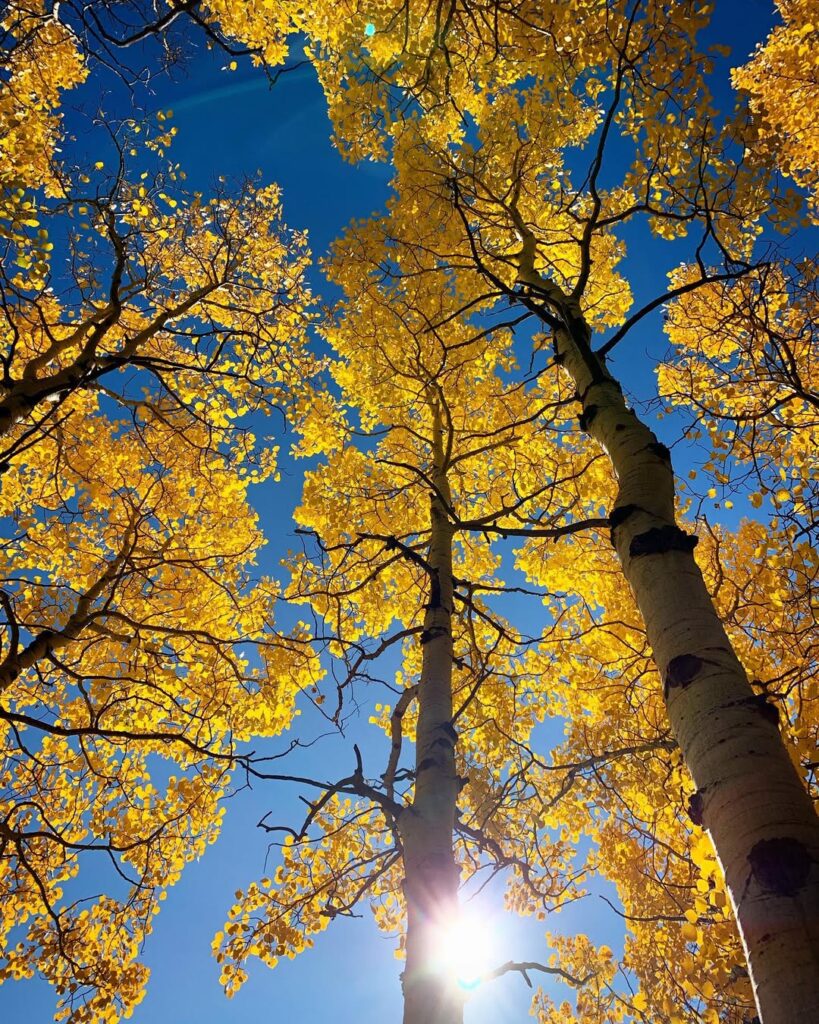
Quaking Aspen is the most widely distributed tree species in North America, reaching up to 25 meters tall with distinctive smooth, pale bark marked by black scars. This deciduous tree is renowned for its glossy green leaves that turn golden yellow in autumn and produce a characteristic rustling sound in the wind due to their flattened petioles.
The species spreads aggressively through root suckering, forming large clonal colonies from a single genetic individual. While short-lived, it establishes rapidly and provides essential habitat for wildlife while playing an important role in early forest succession after disturbances like fire. Its fast growth and striking fall color make it valuable for naturalizing landscapes and restoration projects. The tree serves as important browse for deer, elk, and moose, while its bark is consumed by rabbits, rodents, and porcupines.
- Hardiness: Extremely hardy, naturally occurring from Alaska to northern Mexico
- Light: Full sun required; shade intolerant and declines under closed canopies
- Water: Prefers moist to wet soils but tolerates well-drained sites
- Soil: Adaptable to various soil types including gravelly and wet soils
- Fertilizer: Low requirements; improves soil through natural leaf litter decomposition
- Pest/Disease Resistance: Generally resistant with few serious issues
- Growth Rate: Fast growing with rapid establishment and quick colonization
Western Larch (Larix Occidentalis)
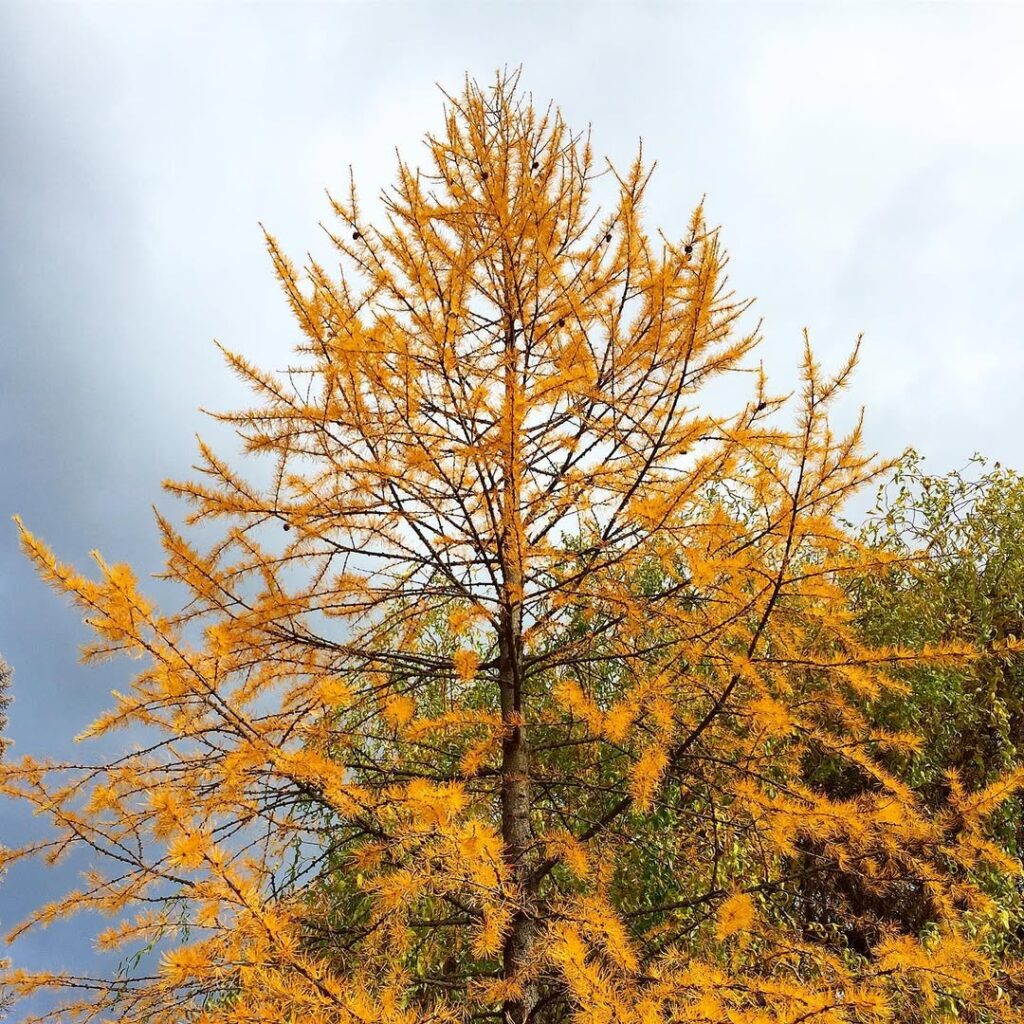
Western Larch is a remarkable deciduous conifer native to the mountains of eastern Washington and surrounding regions. This majestic tree can reach heights up to 50 meters and live for several centuries, distinguished by its soft, bright green needles that turn brilliant golden yellow before dropping each fall. Its thick, deeply furrowed bark and fire-resistant adaptations make it well-suited to the region’s fire-prone forests.
As one of the few deciduous conifers, Western Larch thrives in open, sunny conditions and depends on periodic fire for regeneration. The species forms pure or mixed stands from valley bottoms to subalpine zones, contributing considerably to forest biodiversity and wildlife habitat while playing a vital ecological role in eastern Washington’s forest ecosystems. The seeds provide important winter food for various bird species including pine siskin and redpoll.
- Hardiness: USDA zones 3-6, cold hardy to mountainous conditions
- Light: Full sun required for ideal growth and photosynthesis
- Water: Moderate moisture needs, drought tolerant once established
- Soil: Well-drained soils preferred, adaptable to various soil types
- Fertilizer: Generally unnecessary in native forest conditions
- Pest/Disease Resistance: Excellent resistance to most insects and diseases
- Growth Rate: Moderate to fast in favorable conditions
Oregon White Oak (Quercus Garryana)

Oregon White Oak is Washington’s only native oak species, naturally occurring on both sides of the Cascade Mountains. This majestic deciduous tree reaches heights of 40-90 feet with a distinctive broad, rounded crown and rugged branching pattern. Young trees often appear shrubby before developing their mature form over 25 years.
The species provides exceptional wildlife value, supporting over 200 species including specialized butterflies, birds, and mammals. With a potential lifespan of 500 years, Oregon White Oak forms critical woodland habitats throughout eastern Washington, particularly along the Columbia Gorge and south-central Cascade foothills where it thrives in well-drained soils. The tree produces acorns with shallow cups that enclose about one-third of the fruit, providing an important food source for local wildlife.
- Hardiness: USDA zones 7-9, cold hardy throughout eastern Washington
- Light: Full sun to partial shade
- Water: Drought tolerant once established, moderate water needs
- Soil: Well-drained, moderately deep, acidic soils; tolerates various soil types but prefers deep loams
- Fertilizer: Low requirements; minimal fertilization needed in native soils
- Pest/Disease Resistance: Generally resistant to most pests and diseases when properly sited
- Growth Rate: Slow to moderate; develops shrubby form when young, maturing over 25+ years
Rocky Mountain Juniper
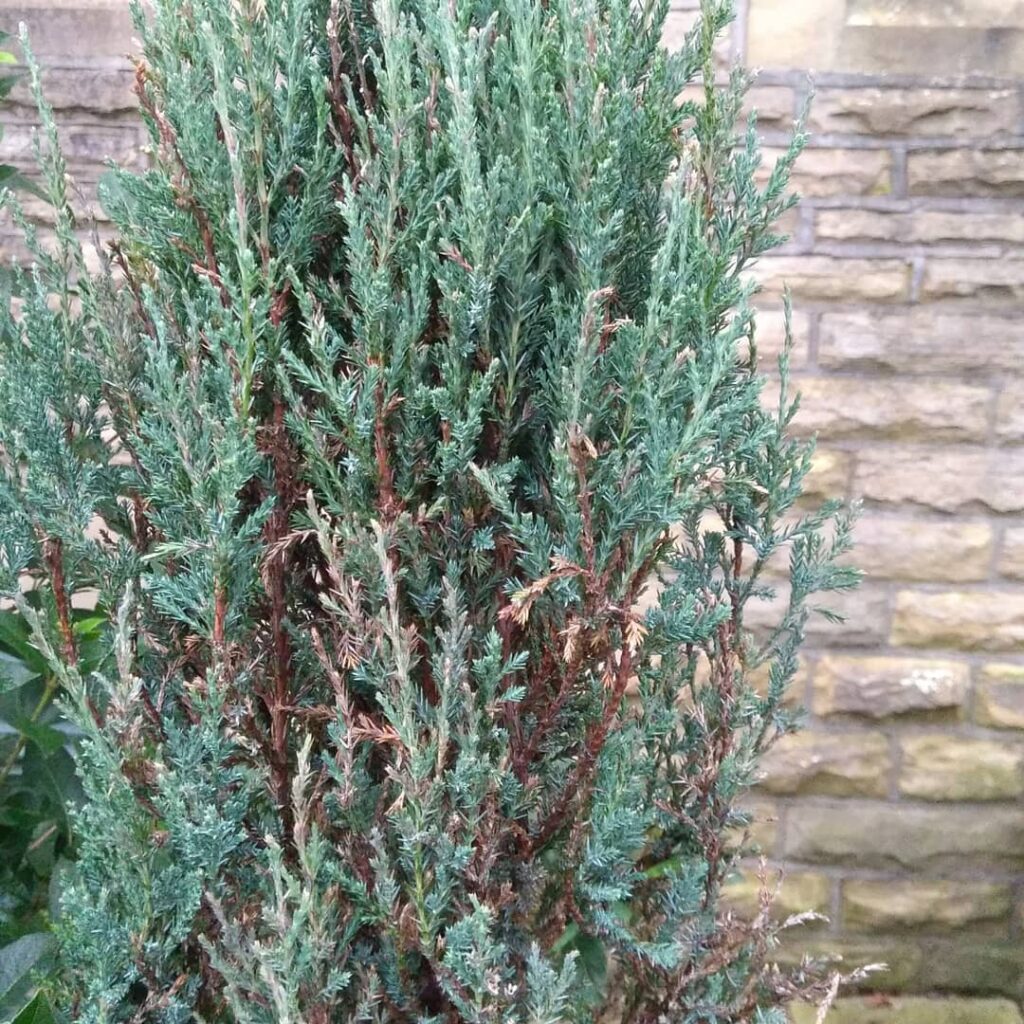
Rocky Mountain Juniper is one of the most widely distributed conifers in western North America and serves as an excellent native choice for Eastern Washington landscapes. This slow-growing evergreen typically reaches 16-49 feet in height and thrives in the region’s dry, mountainous conditions. Found naturally in foothills and interchange zones between grasslands and forests, it forms an important component of local ecosystems while providing valuable wildlife habitat and erosion control on exposed sites.
With exceptional drought tolerance and minimal maintenance requirements once established, Rocky Mountain Juniper makes an ideal choice for xeriscaping and low-input landscapes. Its aromatic, durable wood and historical uses by indigenous peoples add cultural significance, while its ability to thrive on rocky slopes and severe sites demonstrates remarkable resilience in challenging growing conditions. The tree features distinctive reddish-brown bark that breaks into flat ridges on larger specimens.
- Hardiness: Zones 3-7, tolerates temperature extremes of semi-arid climates
- Light: Full sun to partial sun
- Water: Low to moderate; drought-tolerant once established, requires 10-18 inches annual precipitation
- Soil: Well-drained, dry soils; tolerates rocky, poor soils; not suitable for waterlogged conditions
- Fertilizer: None required; adapted to nutrient-poor soils
- Pest/Disease Resistance: Generally resistant; susceptible to late spring frost damage during seedling stage
- Growth Rate: Slow; takes centuries to reach maturity, lifespan exceeds 300 years
Hardy Native Shrubs for Landscaping
Eastern Washington’s hardy native shrubs offer exceptional landscaping solutions, from shrub-steppe specialists and flowering varieties to berry-producing species and climate-adapted options that provide significant ecological benefits. These resilient plants excel in arid climates and challenging soil conditions, making them ideal choices for sustainable landscaping in the region.
Sagebrush (Artemisia Tridentata)
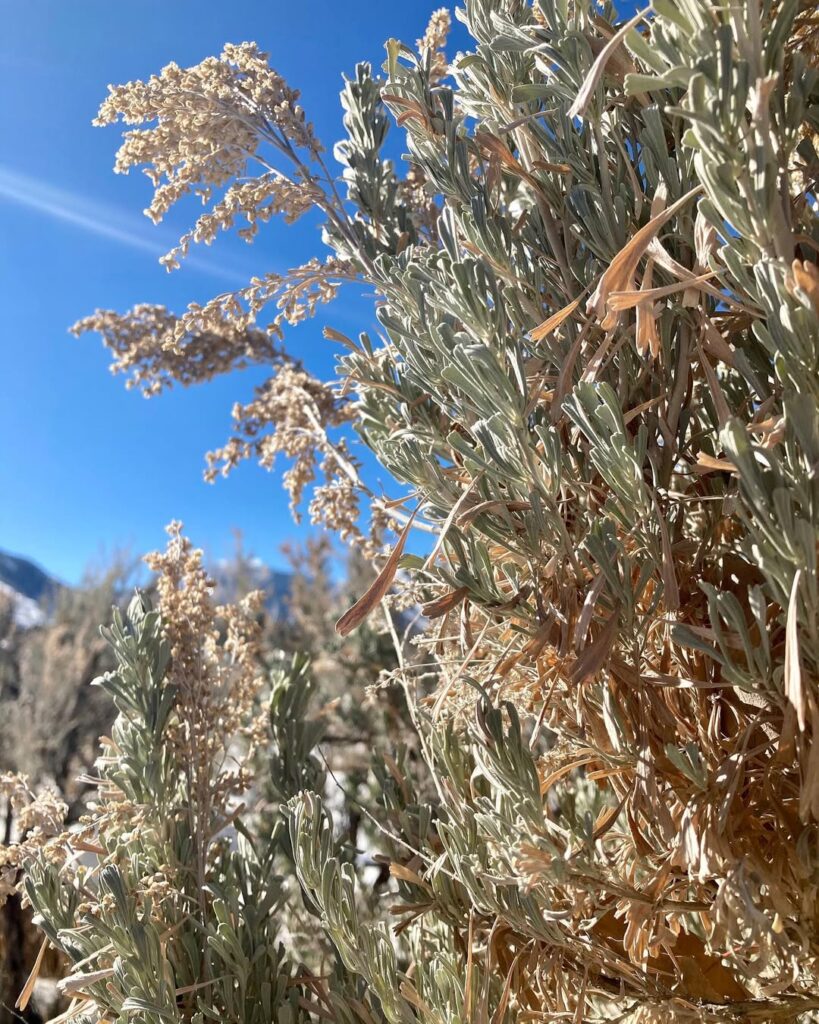
Sagebrush is an aromatic, grayish-green shrub that serves as an excellent foundation plant for xeriscaping in eastern Washington. Growing 3-6 feet tall with year-round foliage, this hardy native provides essential structure to arid landscapes. Its deep taproot system and drought tolerance make it ideal for low-water gardens, while its wildlife value supports birds, insects, and small mammals.
As a prolific colonizer, sagebrush establishes readily from seed and can form natural clones. Though highly flammable due to its aromatic oils, it offers unmatched resilience in harsh climates and poor soils, making it a cornerstone species for sustainable native landscaping. This long-lived shrub often exceeds 100 years once past the seedling stage, making it a permanent investment in your landscape.
- Hardiness: Extremely cold hardy, adapted to temperature extremes in cold desert and mountain habitats
- Light: Full sun
- Water: Low to very low water needs once established; drought tolerant
- Soil: Deep, well-drained soils; tolerates nutrient-poor and alkaline conditions
- Fertilizer: None required; adapted to nutrient-poor soils
- Pest/Disease Resistance: Natural aromatic oils deter most herbivores; generally pest and disease resistant
- Growth Rate: Moderate; slow to establish but long-lived once mature
Serviceberry (Amelanchier Alnifolia)
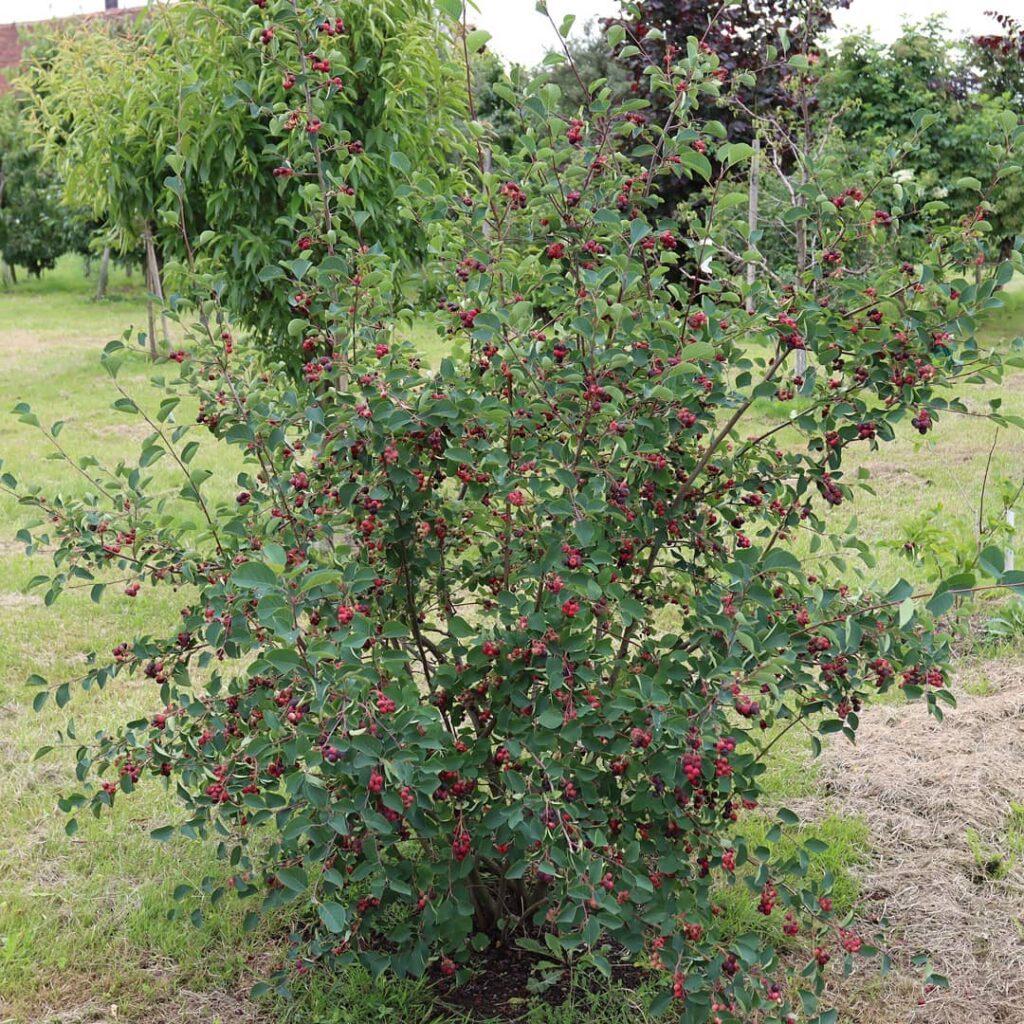
Serviceberry (Amelanchier alnifolia) is an outstanding native shrub that excels in eastern Washington’s climate. This versatile deciduous plant grows 4-12 feet tall with an attractive silver-barked, multi-stemmed form. In late spring, it produces fragrant white star-shaped flowers, followed by dark purple berries in summer that are beloved by wildlife and edible for humans.
This exceptional landscape plant provides year-round interest with spring blooms, summer fruit, brilliant fall color, and attractive winter branching. Its adaptability to fire-prone habitats makes it ideal for firewise landscaping, while its drought tolerance suits eastern Washington’s dry conditions perfectly. The fragrant flowers bloom in racemes containing 3-20 individual blossoms per cluster.
- Hardiness: USDA zones 2-8, extremely cold hardy to Alaska
- Light: Full sun to partial shade, performs well in both conditions
- Water: Drought tolerant once established, moderate water needs during establishment
- Soil: Adaptable to various soil types, tolerates rocky and well-drained soils
- Fertilizer: No fertilizer needed, thrives in native soils
- Pest/Disease Resistance: Excellent resistance, very few pest or disease issues
- Growth Rate: Moderate growth rate, reaching mature size in 5-10 years
Snowberry (Symphoricarpos Albus)
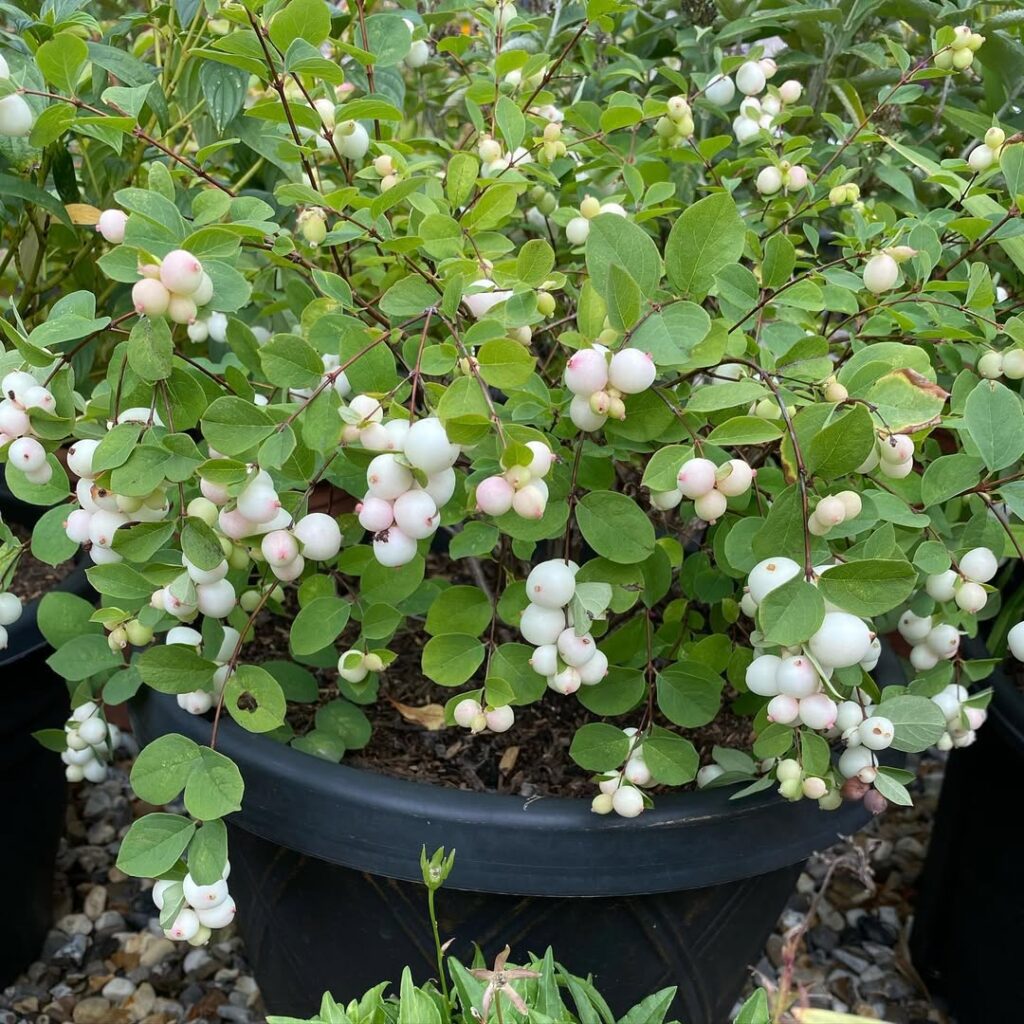
Snowberry (Symphoricarpos albus) is a hardy deciduous shrub native to Eastern Washington, growing 3-4.5 feet tall with dense, twiggy branches. This low-maintenance native produces small pinkish bell-shaped flowers followed by distinctive snow-white berries that persist through winter, providing year-round visual interest.
Excellent for screening and naturalized landscapes, snowberry offers exceptional ecological value by attracting butterflies, birds, and small mammals. The berries serve as winter food sources for wildlife, while flowers support pollinators. Its adaptability to various habitats and ease of cultivation make it an ideal native alternative to non-native ornamental shrubs for Eastern Washington gardens. The plant can resprout from rhizomes after fire, making it particularly valuable for restoration projects in fire-prone areas.
- Hardiness: USDA zones 2-7, extremely cold hardy
- Light: Full sun to partial shade, adaptable to various light conditions
- Water: Drought tolerant once established, minimal supplemental watering needed
- Soil: Adaptable to various soil types, well-draining preferred
- Fertilizer: Low nutrient requirements, typically no fertilization needed
- Pest/Disease Resistance: Generally pest and disease free, very resilient
- Growth Rate: Moderate, reaches mature size in 3-5 years
Mock Orange (Philadelphus Lewisii)
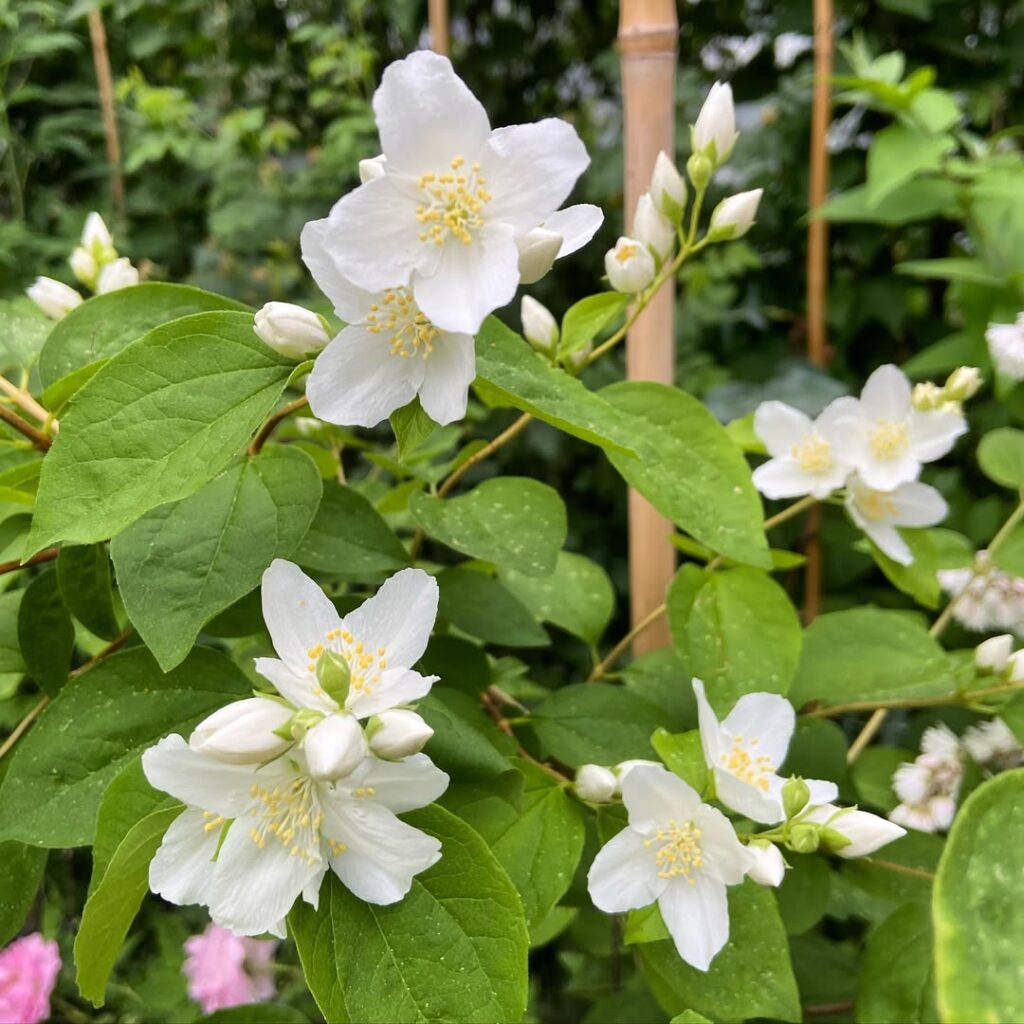
Mock Orange (Philadelphus lewisii) is a versatile native shrub that brings exceptional beauty to Eastern Washington landscapes. Reaching 4.5-10 feet tall with graceful arching stems, this deciduous shrub produces clusters of intensely fragrant white flowers from late spring to early summer. The blooms attract pollinators while providing wildlife habitat through dense branching.
Discovered by Lewis during the famous expedition, this hardy shrub adapts to diverse conditions from streambanks to dry hillsides. Its low-maintenance nature and stunning floral display make it ideal for specimen plantings, mixed borders, or naturalistic gardens. The plant tolerates pruning well and offers year-round interest through seasonal changes. As the state shrub of Idaho, Mock Orange holds special significance in the Pacific Northwest region.
- Hardiness: Very hardy, thrives in Pacific Northwest conditions
- Light: Full sun to partial shade (full sun preferred for best flowering)
- Water: Drought tolerant once established, tolerates temporary wetness
- Soil: Adaptable to various soil types, both moist and dry conditions
- Fertilizer: Low fertilizer requirements, thrives in native soils
- Pest/Disease Resistance: Excellent resistance with minimal issues reported
- Growth Rate: Moderate growth rate with multi-stemmed structure
Ninebark (Physocarpus Malvaceus)

Ninebark (Physocarpus malvaceus) is a versatile deciduous shrub native to eastern Washington and the mountain regions of the Pacific Northwest. Growing 2-7 feet tall with an attractive vase-shaped form, this hardy shrub features palmately lobed leaves and clusters of small white flowers that bloom from late spring to early summer. The exfoliating bark adds winter interest, while fall foliage ranges from intense red to rose-brown.
This drought-tolerant shrub excels in challenging landscapes, thriving on rocky hillsides, grasslands, and forest edges at elevations up to 10,000 feet. Its prolific seed production and rhizomatous root system make it excellent for erosion control and restoration projects. Ninebark provides valuable pollinator habitat, particularly for bumblebees, and its fire-adapted nature makes it ideal for sustainable, low-maintenance landscapes in eastern Washington’s dry climate. As a member of the rose family, it shares characteristics with many other valuable landscape plants.
- Hardiness: Cold hardy, suitable for elevations 5,250-10,000 feet
- Light: Full sun to partial shade
- Water: Drought tolerant; prefers dry to moderately moist conditions
- Soil: Well-drained soils; tolerates rocky and sloped sites
- Fertilizer: Low requirements; adapted to native soil conditions
- Pest/Disease Resistance: Generally resistant with few reported issues
- Growth Rate: Moderate establishment rate; perennial with rhizomatous spread
Selecting the Right Native Plants for Your Garden
How do you choose plants that’ll actually survive Eastern Washington’s harsh conditions while creating a beautiful, low-maintenance garden? Start by matching plants to your specific site conditions—elevation, soil type, and sun exposure matter more than general regional advice.
Focus on plant adaptation to your microclimate. Native grasses like Idaho Fescue handle poor drainage, while Penstemon species thrive in rocky soils without soil improvement. Choose locally sourced stock whenever possible, as these plants carry genetic traits suited to your area’s unique conditions.
Mix perennials, shrubs, and grasses for year-round interest and biodiversity support. Consider the unique shrub-steppe ecosystem of Eastern Washington when planning your plant combinations, as this environment supports specialized plant communities adapted to semi-arid conditions.
Frequently Asked Questions
When Is the Best Time to Plant Native Species in Eastern Washington?
If you’d planted sagebrush last October, it’d survive this summer’s drought better. The best planting season is fall through early spring, considering seasonal weather considerations like avoiding summer heat stress and winter freezes.
How Often Should I Water Newly Planted Native Plants During Establishment?
During the establishment period, you’ll want to follow a watering schedule of once every 7-10 days in dry winters, then shift to deep watering twice weekly as your plants begin establishing roots.
Do Native Plants in Eastern Washington Require Special Fertilizers or Soil Amendments?
You don’t need special fertilizers or soil amendments for Eastern Washington natives. These plants have naturally adapted to local soil quality, so their fertilization needs are minimal once they’re established in existing conditions.
Which Native Plants Attract Local Wildlife Like Birds and Pollinators?
You’ll discover bird friendly flowers like Great Camas and Coast Penstemon create stunning pollinator habitats. These natives attract bumblebees, butterflies, and moths while Douglas fir and native shrubs provide essential nesting sites.
Where Can I Purchase Native Plant Seeds and Seedlings in Eastern Washington?
You’ll find excellent seed sources and local nurseries throughout eastern Washington. Try Tapteal Native Plants in West Richland, Desert Jewels in Spokane, or Plants of the Wild in Tekoa for quality native seedlings.
